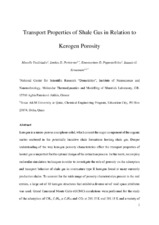| dc.description.abstract | Kerogen is a micro-porous amorphous solid, which consist the major component of the organic
matter scattered in the potentially lucrative shale formations hosting shale gas. Deeper
understanding of the way kerogen porosity characteristics affect the transport properties of
hosted gas is important for the optimal design of the extraction process. In this work, we employ
molecular simulation techniques in order to investigate the role of porosity on the adsorption
and transport behavior of shale gas in overmature type II kerogen found at many currently
productive shales. To account for the wide range of porosity characteristics present in the real
system, a large set of 60 kerogen structures that exhibit a diverse set of void space attributes
was used. Grand Canonical Monte Carlo (GCMC) simulations were performed for the study
of the adsorption of CH4, C2H6, n-C4H10 and CO2 at 298.15 K and 398.15 K and a variety of
2
pressures. The amount adsorbed is found to correlate linearly with the porosity of the kerogen.
Furthermore, the adsorption of a quaternary mixture of CH4, C2H6, CO2 and N2 was
investigated in the same conditions, indicating that the composition resembling that of the shale
gas is achieved under higher temperature and pressure values, i.e. conditions closer to these
prevailing in the hosting shale field. The diffusion of CH4, C2H6 and CO2, both as pure
components and as components of the quaternary mixture, was investigated using equilibrium
Molecular Dynamics (MD) simulations at temperatures of 298.15 and 398.15 K and pressures
of 1 and 250 atm. In addition to the effect of temperature and pressure, the importance of
limiting pore diameter (LPD), maximum pore diameter (MPD), accessible volume (Vacc) and
accessible surface (Sacc) on the observed adsorbed amount and diffusion coefficient was
revealed by qualitative relationships. The diffusion across the models was found to be
anisotropic and the maximum component of the diffusion coefficient to correlate linearly with
LPD, indicating that the controlling step of the transport process is the crossing of the limiting
pore region. Finally, the transport behavior of the pure compounds was compared with their
transport properties when in mixture and it was found that the diffusion coefficient of each
compound in the mixture is similar to the corresponding one in pure. This observation agrees
with earlier studies in different kerogen models comprising wider pores that have revealed
negligible cross-correlation Onsager coefficients. | en |



